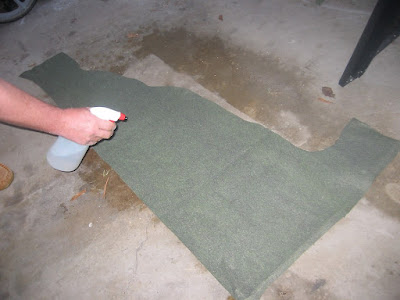After letting the first color dry overnight, I moved on to the Dark Flesh tone. I applied this heavily, not quite drybrushing. Some of the darker color still shows, but it is fine to cover it completely in areas. I again blend the color out into the grass, extending the color slightly beyond the darker tone. It still looks clunky at this stage, but as we go on, the layers will really start to blend in with the grass. You need to make sure each color is dry before adding the next one. Since I was working on six boards at one time, the color was usually dry on the first one when I got finished with the sixth and I was able to roll - all of this was done in a single afternoon and I even wasted time setting up the camera!
A lot of the blending is done by "stippling" or dabbing the color onto the grass areas. Start with a fairly dry brush and go over sections multiple times to build it up until it looks right to you. Writing about painting is like dancing about carpentry, but hopefully the photos help to illustrate the point.
On to step three... Bestial Brown (love these color names)! Now we are getting more into drybrushing. You will begin to see the textured paint pay off and as you drybrush and stipple the color onto the edge where the earth and grass meet, the areas will start to blend more.
For the fourth stage and I used Bubonic Brown. I actually lightly drybrushed almost the entire board including the grass with this color too to add some variation in the grass tone and help blend the different areas together even more.
One more color and we are finished! Well, sort of. The last coat isBleached Bone and is applied as lightly as possible, concentrating on the highest elevations, the center of the roads, etc. Once again, I drawthe brush out across the grass areas as well. It's not necessary to hit every spot with this as we want some variation.
Ok, these things are starting to look pretty cool. We could actually stop here and more onto the river, but I want to add some more color into the boards so we're going to paint in some gray rocks in the next post, which will be up in a few days! I will also be adding static grass in areas to add yet another color and texture.





































